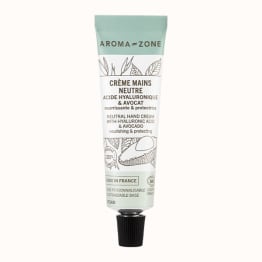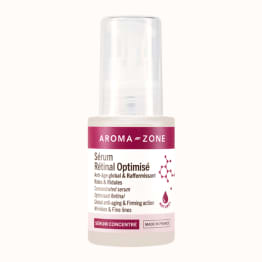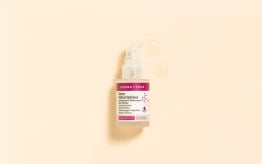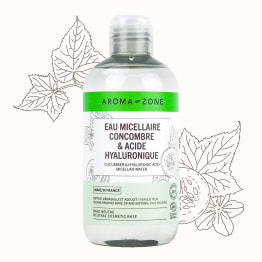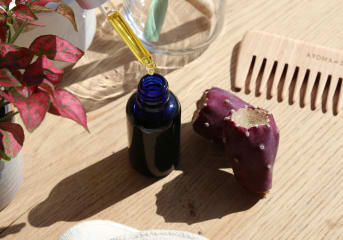How do you combine Hyaluronic Acid with your skin serums?
Hyaluronic acid serum is the ultimate all-rounder. It has the advantage of being suitable for all skin types (oily, combination, normal, dry) and all ages. Often considered to be the best facial serum, it is mainly used to prevent dehydration and the signs of ageing. But that's not all! To increase the benefits of your Aroma-Zone Hyaluronic Acid Serum, you can combine it with other skincare serums. Vitamin C, Retinal, Bakuchiol, Glycolic Acid, Nicotinamide, etc. Find the right duo to personalise your beauty routine and improve the appearance of your skin every day. Here's our expert advice.

Contents
Focus on our Aroma-Zone Hyaluronic acid serum

Our 100% natural hyaluronic acid serum is one of the most concentrated on the market: 3.5% compared with 0.1 to 1% hyaluronic acid in conventional cosmetics.
Renowned for smoothing, moisturising and plumping the skin, its fresh, naturally gelled texture penetrates instantly without fluffing or pulling. Its effectiveness as an anti-ageing serum has been tested and proven to fill in wrinkles, hydrate and improve skin elasticity .
Vitamin C + Hyaluronic Acid Serum
Vitamin C (ascorbic acid) is one of the iconic active ingredients in anti-ageing cosmetics. It is renowned for its powerful antioxidant properties. It is compatible with hyaluronic acid skin serums. So you can combine these two substances in your routine

Focus on our 10% Vitamin C & Astaxanthin serum concentrate
This highly concentrated face serum with 10% vitamin C is a beauty elixir and radiance booster for the skin. A benchmark active ingredient for dull skin and a must-have in anti-ageing skincare, vitamin C stimulates collagen synthesis, fights the signs of photo-ageing, evens skin tone and reduces dark spots.
For which skin types?
The combination of a Vitamin C serum and Hyaluronic Acid is suitable for all skin types. Our experts particularly recommend it for mature and ageing skin, characterised by reduced collagen synthesis and a tendency towards hyperpigmentation. It is also ideal for normal skin in search of greater radiance.
What skin issues?
The combination of hyaluronic acid with a vitamin C serum is ideal for:
Improving complexion evenness and illuminating the skin.
Fading pigmentation irregularities (lentigo, brown spots).
Protecting the skin's moisture balance and plumping its appearance.
Preventing the appearance of fine lines and wrinkles.
What dose?
Plan on one dose of Hyaluronic acid skincare and one dose of Vitamin C serum. However, you can also create your own dosage depending on the effects you're looking for. Use two doses of Hyaluronic acid serum for one dose of Vitamin C if you want to focus on hydration. Do the opposite to target your pigmentation spots and the radiance of your complexion.
How can they be combined?
Type of galenic formulation. Make sure that your hyaluronic acid product (cream, serum) does not contain any ingredients that are incompatible with ascorbic acid (e.g. Nicotinamide).
Method of application. Use one product in the morning and another in the evening. Use them separately if you are using a cream on top of your serum. Vitamin C products are often oily, so use them on top of your hyaluronic acid anti-ageing serum (and not the other way round).
Frequency of use. This duo can be used daily. It is also ideal as a "cure" during the summer.
When to apply them?
Hyaluronic Acid and Vitamin C are not photosensitising. You can therefore apply them in the morning or evening. Aim for one or two applications a day. If you have sensitive skin, don't hesitate to space out applications if you experience discomfort.
Glycolic Acid + Hyaluronic Acid Serum
Glycolic acid (also known as hydroxyacetic acid) is a member of the large family of fruit acids (AHAs). It is best known for its powerful exfoliating properties. Combining it with a hyaluronic acid treatment can help prevent skin dehydration.

Focus on our 10% Glycolic acid & AHA serum concentrate
Brighten up your complexion with our face serum, highly concentrated in glycolic acid and AHA fruit acids!
Thanks to its exfoliating effect, this serum eliminates dead cells and stimulates skin renewal for a radiant, even complexion. Particularly suitable for skin marked by the sun, smoking or premature ageing, it reduces acne scars and smoothes irregularities.
It also tightens pores, fights blackheads and reduces wrinkles and dark spots.
For which skin types?
This duo is ideal for combination and oily skin. This is the case if your skin easily develops blemishes (blackheads) and/or if it shines during the day (excess sebum). It is also suitable for all skin types showing the first signs of ageing.
What skin issues?
The combination of hyaluronic acid and a glycolic acid serum may be recommended for the following benefits.
Smoothes skin texture and reduces the appearance of open pores.
Prevent the appearance of blackheads.
Helps maintain the skin's natural moisture level.
What dose?
Glycolic acid is a powerful active ingredient. There's no need to use too much. The more dehydrated your skin, the more you can increase the dosage of your moisturising serum (Hyaluronic Acid) at the same time.
How can they be combined?
Type of galenic formulation. If you choose a hyaluronic acid cream, make sure you apply it on top of the glycolic acid serum to limit the evaporation of moisture.
How to apply. You can apply the products together or at different times in your skincare routine. Avoid layering too many active ingredients. Apply them separately if you are following them with a cream. For example: Hyaluronic acid + cream in the morning, then glycolic acid + cream in the evening.
Frequency of application. This combination is ideal as a "treatment" for a new skin effect. Apply the two products together for 3 to 4 weeks.
When to apply them?
Unlike a Hyaluronic acid treatment, Glycolic acid cannot be used at any time of the day. Apply it only in the evening, at bedtime. Remember to wear sun protection for one week after the last use.
Nicotinamide + Hyaluronic Acid Serum
Nicotinamide is a vitamin B3 derivative. In cosmetics, it has sebum-regulating, soothing, anti-ageing and anti-dark spot properties. It can be combined with a moisturising serum containing pure Hyaluronic acid, particularly to reduce redness and soothe skin discomfort.

Focus on our 10% Nicotinamide, Copper & Zinc serum concentrate
Highly concentrated in Nicotinamide (vitamin B3), Zinc and Copper, our face serum regulates sebum secretion, tightens pores, prevents the formation of pimples and reduces redness and brown spots.
An elixir for 'flawless skin', it leaves the skin clear, the complexion even-toned and the texture refined. It's THE must-have skincare product for oily, combination, acne-prone and blemish-prone skin!
Discover our 10% Nicotinamide, Copper & Zinc serum concentrate
For which skin types?
This duo achieves a rare feat: it is suitable for both sensitive skin and skin with imperfections. Most of the time, purifying skincare products designed for oily skin (blackheads) are little appreciated by delicate skin. Here, it is ideal for reinforcing the skin's protective barrier.
What skin issues?
Using a hyaluronic acid skin serum with a Nicotinamide skincare product can help to address the following concerns:
Even out skin tones prone to redness.
Firm the skin's appearance.
Reduce hyperpigmentation (such as pimple marks).
Fight excess sebum and shine.
What dose?
Our serum has one of the highest concentrations of hyaluronic acid on the market (3.5%). Our Nicotinamide treatment contains 10% Nicotinamide for optimum effectiveness. Just a few drops are all you need for each use!
How can they be combined?
Type of galenic formulation. As these two products are aqueous (formulated with water), they are particularly easy to combine. Most of the time, they are light, fast-absorbing serums.
How to apply. Ideally, start by applying the Hyaluronic Acid serum, then finish with the Nicotinamide serum. If you want to seal in with a moisturiser, apply your serums at different times (one in the morning, one in the evening). If your skin barrier has been damaged, finish off with a sun protection product.
Frequency of application. This combination is suitable for daily use. Feel free to adjust the frequency of use according to your skin's needs.
When to apply them?
Each of these two products can be applied at any time of day, either separately or together. If you want to support your skin's natural repair, apply Nicotinamide in the evening. Using a hyaluronic acid moisturising serum in the morning helps to protect the skin against external aggressors (dehydration).
Retinol + Hyaluronic Acid Serum
A star of anti-ageing cosmetics, Retinol is a must-have for preventing the signs of ageing. However, this form of vitamin A can sometimes have undesirable effects on sensitive skin. So we've come up with a gentler, more active alternative: Retinal.

Focus on our Optimised retinal serum concentrate
This serum offers overall anti-ageing effectiveness by targeting the appearance of wrinkles, spots and sagging skin. It is enriched with Retinal (an intermediate form of the transformation of Retinol into Retinoic Acid, considered to be better tolerated by the skin) combined with Mastic Tree extract for optimum performance. Its 100% natural formula with a light, gentle texture is suitable for all skin types, even delicate skin. It helps to restore a clearer, more radiant complexion as the night goes by.
For which skin types?
Retinal has similar properties to the Retinol found in conventional cosmetics. Like Retinol, it is compatible with other hyaluronic acid serums. This combination is particularly suitable for mature skin (dull complexion, wrinkles, spots, etc.). It is also suitable for sensitive skin.
What skin issues?
Applying a Retinol (or Retinal) serum with a Hyaluronic Acid serum can improve the appearance of the skin in the following areas of concern.
Preventing sagging skin.
Smoothing the appearance of fine lines and wrinkles.
Purifying the skin and tightening pores.
Reducing the intensity of traces of hyperpigmentation.
What dose?
A dab of each product is more than enough. For intense hydration, increase the dosage of your hyaluronic acid serum.
How can they be combined?
Type of galenic formulation. These two active ingredients are available in both cream and serum form. However, serums are the most common and often the most interesting in terms of concentration. If you absolutely must have an emulsion, try the following combination: Retinal serum + Hyaluronic acid cream.
How to apply. Because of its slight film-forming effect, it's best to apply your Hyaluronic acid cream separately. Apply it during your morning routine and keep the Retinal treatment for bedtime.
Frequency of application. Start by using your Retinal treatment twice a week. Gradually increase the frequency until you find a rhythm that suits you. You can also use Hyaluronic acid continuously.
When to apply them?
Even though the risk of photosensitivity is reduced, we recommend that you apply your Retinal skin care product in the evening. This will provide the best possible support for your nocturnal cell renewal. Sun cream is optional. Your Hyaluronic Acid Plumping Serum can be used in the morning and/or evening.
Bakuchiol + Hyaluronic Acid Serum
Bakuchiol is a little-known ingredient, but scientifically recognised for its benefits on blemishes and the signs of ageing. It is 100% natural and plant-based, and is often presented as an ingredient with Retinol-like properties - minus the risk of irritation and photosensitivity.

Focus on our Bakuchiol serum concentrate for the face
Both anti-ageing and blemish-fighting, our natural face serum contains a high concentration of Bakuchiol, a revolutionary active ingredient recognised as the plant-based alternative to retinol.
An antioxidant, regenerator and collagen booster, this natural active ingredient extracted from Babchi seeds helps to maintain skin firmness, smooth fine lines and reduce dark spots.
It also improves the condition of acne-prone skin, regulating, repairing and purifying it without harming it.
For which skin types?
This combination is ideal for mature and dry skin, helping to prevent the signs of ageing. It is particularly suitable for skin with imperfections. You can also try it for dull complexions or skin that looks asphyxiated and devitalised.
What skin issues?
You can use Hyaluronic Acid in combination with Bakuchiol to address the following concerns.
Improving the skin's radiance and apparent vitality.
Stimulate collagen synthesis to maintain skin firmness.
Reduce the appearance of dark spots.
Prevent the formation of open and closed comedones (blackheads, whiteheads, etc.).
What dose?
Our serum contains 1% Bakuchiol, which is the optimum dosage for effectiveness. Measure out the product so that you have enough material to cover your face, eye contour and neck. Adjust the dosage of your Hyaluronic Acid product according to your level of dehydration.
How can they be combined?
Type of galenic formulation. Our Bakuchiol serum is formulated on a Squalane base, an olive oil derivative with a fine, non-greasy texture. The hyaluronic acid serum, on the other hand, is water-based. These two products should therefore be applied in a certain order.
How to apply. Start with your hyaluronic acid serum and finish with the Bakuchiol treatment. Its lipids will form an imperceptible anti-dehydration barrier on the surface of your skin.
Frequency of application. These two products can be used daily, alone or in combination. Adapt their frequency of use to your skin's needs.
When to apply them?
Both serums can be used in the morning or evening. Unlike Retinol, Bakuchiol does not increase the skin's sensitivity to the sun. The oil base of our serum with Bakuchiol is ideal for application in the morning to limit imperceptible water loss during the day.
Azelaic acid + Hyaluronic acid serum
Azelaic acid is the all-rounder for blemish-prone skin. It has the advantage of offering a broad spectrum of action on the concerns of combination and oily skin with a tendency to acne. Use this powerful acid if you want a clear, balanced complexion with a clarified appearance. You can also combine it with a hyaluronic acid serum for extra hydration.

Focus on our 10% Azelaic acid serum concentrate
A comprehensive anti-imperfection treatment, this serum combats blackheads, excess sebum, dilated pores and redness. Concentrated with 10% Azelaic Acid, it is also enriched with Hyaluronic Acid (moisturising, plumping), Silica (absorbing) and Plant-based Salicylic Acid (keratolytic). Simple and effective, its formula contains 100% ingredients of natural origin.
It's the essential skincare product for acne-prone skin. The purifying benefits of Azelaic acid help to prevent the spread of the bacteria responsible for acne (Cutibacterium acnes). At the same time, its soft, light texture helps to restore an even, delicately velvety complexion.
For which skin types?
Azelaic acid serum is suitable for skin that regularly has blackheads (open or closed) and a shiny appearance. We recommend it primarily for combination to oily skin, but also for young skin with a tendency to acne. It is also suitable for skin affected by rosacea, as a complement to an appropriate treatment (subject to medical approval, of course). It is also useful for revitalising dull, asphyxiated complexions. In the latter case, its use in conjunction with a hyaluronic acid skin serum may be even more effective.
What skin issues?
You can combine a hyaluronic acid skincare product with an azelaic acid serum if your beauty goals are to:
Restore a clear, healthy-looking complexion without redness.
Combat the formation of blackheads.
Tighten the appearance of open pores. (Don't forget that open pores can also be a sign of latent dehydration, which is why Hyaluronic acid is so useful).
Smooth and mattify the skin's surface if it feels rough or shiny.
What dose?
The 10% concentration of our Azelaic acid skincare product is designed to offer optimum effectiveness. So there's no need to apply too much, as it won't make it any more effective than it already is. Just a few drops are enough to cover your face, neck and décolleté. If you have dehydrated skin, don't hesitate to increase the amount of Hyaluronic acid Moisturising Serum.
How can they be combined?
Type of galenic formulation. Both our serums have an aqueous base. Their light texture is therefore best applied to clean skin, just before your nourishing oil or moisturiser. If you opt for a cream formula with hyaluronic acid, make sure you apply it after your serum.
How to apply. If you apply your serums one after the other, preferably start with the Azelaic Acid serum. Be careful to avoid the eye area. Wait a few seconds, then continue with our 3.5% Hyaluronic Acid serum.
Frequency of application. These two products can be used alone or together once or twice a day. Don't hesitate to adapt the frequency of use to your skin's needs. During periods when imperfections are likely to develop, you can apply your Azelaic Acid treatment twice a day (morning and evening).
When to apply them?
"Acid" does not necessarily mean "photosensitising". In this case, neither Hyaluronic acid nor Azelaic acid increases your skin's sensitivity to the sun. So you're free to apply them whenever you like, in the morning and/or evening. If you're not sure, our Azelaic acid serum is particularly welcome in the morning. Its formula is ideal for blurring the appearance of pores and preventing shine. The perfect way to prepare your skin for make-up!
Focus on our specialist editor, Hélène Betoux

Hélène Betoux is a French beauty journalist specialising in web media. Every day she writes tips, advice and guides to help consumers choose the right beauty products. With a strong interest in natural, organic and clean cosmetics, she analyses and shares trends and innovations in the sector.
